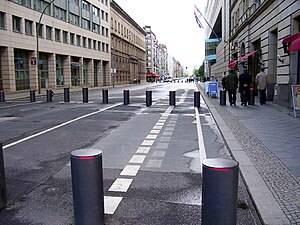User:Edinborgarstefan/Sandbox2



Wilhelmstraße is a street in the center of Berlin, the capital of Germany. Because of the many governmental offices situated in the area from the later half of the 19th century to the middle of the 20th century the top of the German governmental administration became known as The Wilhelmstrasse.
Wilhelmstraße runs south from the Unter den Linden, on a line slightly east of south, until its juncture with the Stresemannstraße near the Hallesches Ufer, a distance of about two kilometres. It is crossed (as one heads south) by Behrenstraße, Leipziger Straße and Zimmerstraße, which to the west of the Wilhelmstraße becomes Niederkirchnerstraße (known before World War II as Prinz-Albrecht-Straße).
A street along this line has existed since the early 18th century, and was known as Husarenstraße (Street of the Hussars) until 1740, when it, along with the Friedrichstraße, which runs roughly parallel to the east, were given their current names to commemorate Friedrich Wilhelm I of Prussia, who had done much to develop the area.
Originally a wealthy residential street, with a number of palaces belonging to members of the Prussian royal family, the Wilhelmstraße developed as a government precinct from the mid 19th century. Among the buildings on the street were the Reich President's official residence, the new Reich Chancellery and the German Foreign Office.
All the major public buildings along the Wilhelmstraße were destroyed by Allied bombing during 1944 and early 1945, apart from the Air Ministry. This building was at Wilhelmstraße 81-85, south of Leipziger Straße, a huge edifice built on the orders of Hermann Göring between 1933 and 1936. It escaped major damage during the war. As one of the few intact government buildings in central Berlin, it was occupied by the Council of Ministers of the new German Democratic Republic in 1949. As such it was at the centre of the popular demonstrations during the workers' uprising of 17 June 1953.
The Wilhelmstraße as far south as the Zimmerstraße was in the Soviet Zone of occupation, and apart from clearing the rubble from the street little was done to reconstruct the area until the founding of the GDR in 1949. The communist GDR regime regarded the former government precinct as a relic of Prussian and Nazi militarism and imperialism, and had all the ruins of the government buildings demolished in the early 1950s. In the late 1950s there were almost no buildings at all along the Wilhelmstraße from Unter den Linden to the Leipziger Straße. In the 1980s, apartment blocks were built along this section of the street.
From 1964 to 1991, when the street as far south as Zimmerstraße was in the territory of the GDR, this section was named Otto-Grotewohl-Straße, after Otto Grotewohl, who was Prime Minister of the GDR from 1949 to 1964.
Today the Wilhelmstraße is an important traffic artery, but has not regained its former status. The Air Ministry building today houses the German Finance Ministry. This, the Agriculture Ministry and the British Embassy are the only public buildings on the street. Many of the occupants of the apartment blocks are recent immigrants, and there are a number of shops and restaurants catering to Russians and Turks.
In recent years the City of Berlin has placed a series of historical markers along the Wilhelmstraße, showing where the well-known buildings of the pre-war era stood.
